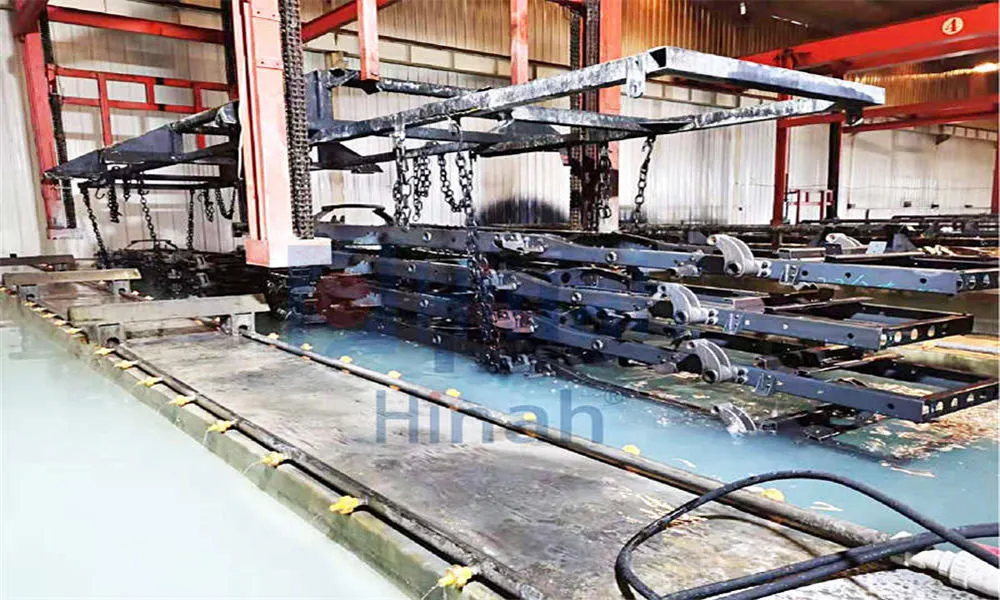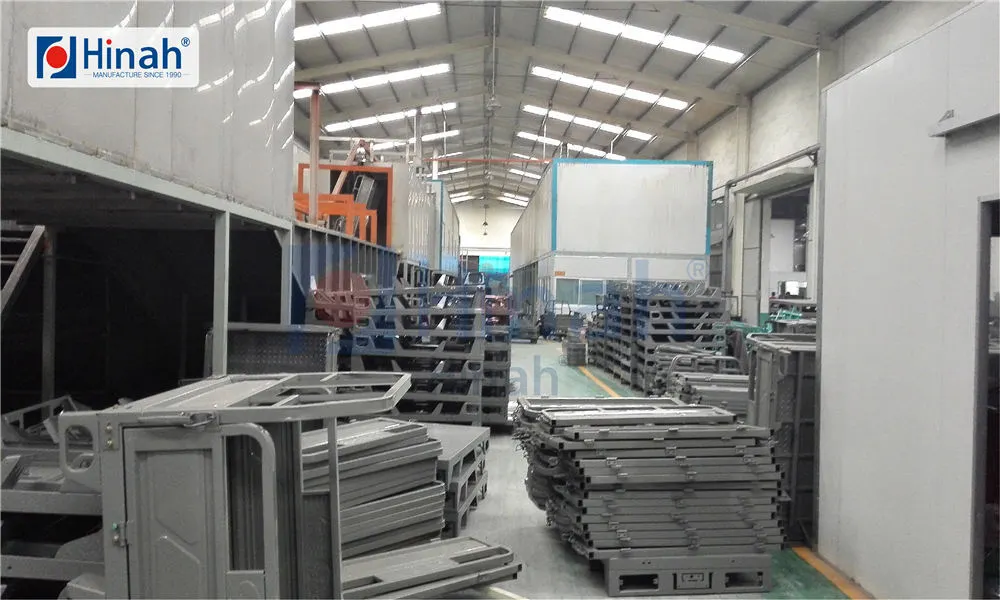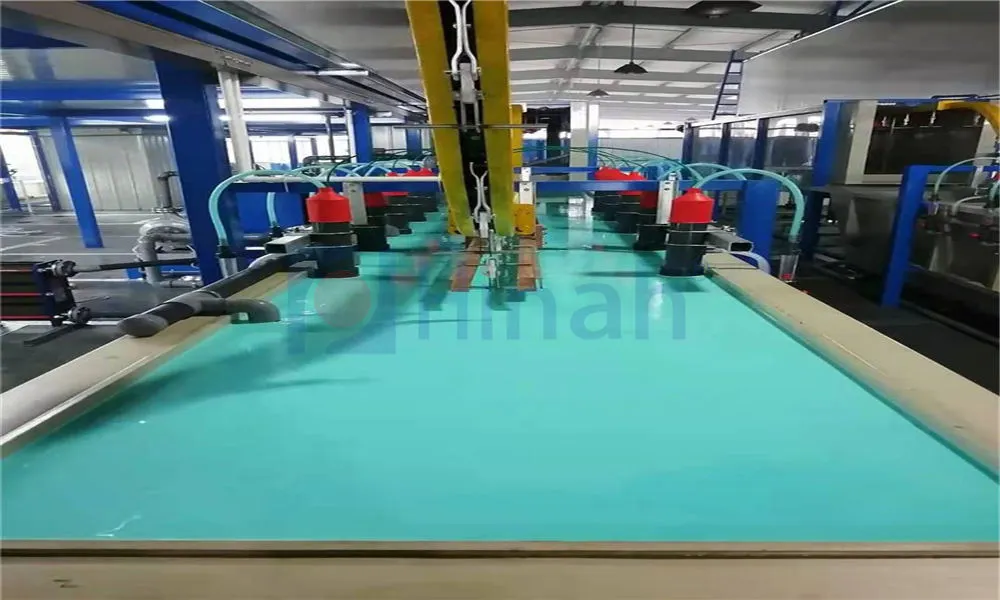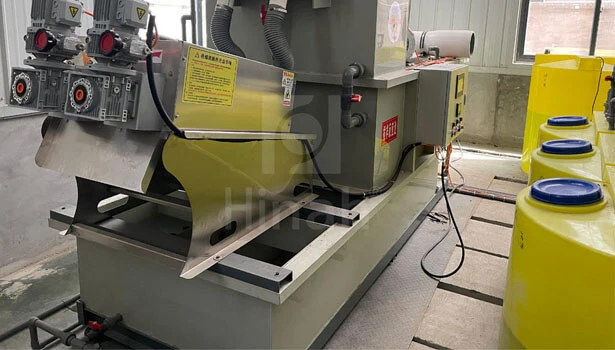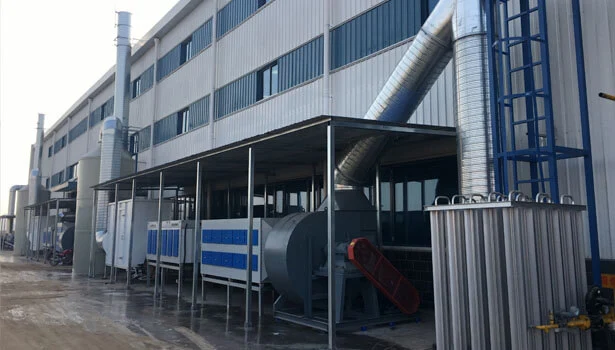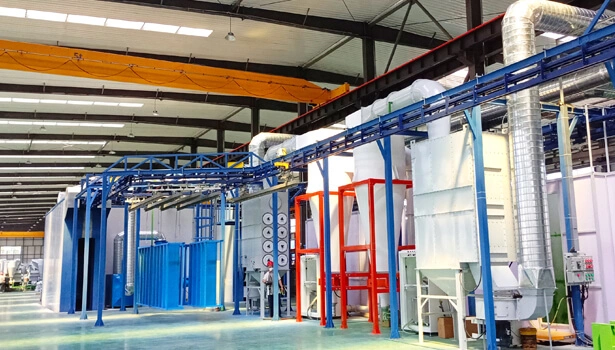The E-Coating Process: Science and Fundamentals for Electric Appliances
At the heart of any Electric Appliances E-Coating Line lies the electrodeposition process itself. Understanding this science is crucial for optimization.
The Principle: E-coating utilizes electrical current to deposit paint uniformly onto conductive substrates immersed in a water-based bath. The appliance part acts as one electrode (usually the anode in cathodic systems), while counter-electrodes are positioned within the tank.
Deposition Mechanism: Charged paint particles (resins, pigments, additives) migrate towards the oppositely charged part when voltage is applied. Upon reaching the part's surface, electrochemical reactions cause the particles to lose their charge and deposit, forming an initial film.
Film Formation: This initial deposition is followed by a critical phase called "throwing power." The deposited film itself acts as an insulator. Current seeks paths of least resistance, flowing to areas with thinner film build, ensuring remarkably uniform coverage even on complex geometries, recesses, and edges – a significant advantage for intricate appliance parts.
Bath Composition: Modern Electric Appliances E-Coating Line baths are complex formulations. They typically contain:
Resin: The backbone of the film, determining properties like flexibility, adhesion, and chemical resistance (epoxy, epoxy-acrylic, acrylic are common).
Pigments: Provide color, opacity, and sometimes functional properties (e.g., corrosion inhibitors).
Additives: Stabilize the bath, control flow, prevent cratering, enhance surface wetting.
Deionized Water: The primary carrier, ensuring low conductivity for optimal deposition control.
Cathodic vs. Anodic: Most modern Electric Appliances E-Coating Lines utilize cathodic e-coat. Here, the part is the cathode (negatively charged), depositing positively charged paint particles. Cathodic systems offer superior corrosion resistance compared to older anodic systems, making them the industry standard for demanding appliance applications.
Pretreatment: The Critical Foundation for E-Coat Success
The performance of the e-coat film is fundamentally dependent on the condition of the substrate beneath it. Pretreatment is arguably the most crucial stage in the entire Electric Appliances E-Coating Line.
Purpose: To remove contaminants (oils, greases, drawing compounds, dirt, oxides, rust) and create a clean, uniformly active surface that promotes maximum adhesion and corrosion resistance for the e-coat.
Typical Stages in an Appliance Line:
Cleaning: Alkaline or acidic cleaners remove oils, greases, and particulate soils. Stages often include spray, immersion, or a combination, with specific chemistries tailored to the soil types common in appliance part fabrication (e.g., stamping lubricants).
Rinsing: Multiple thorough rinsing stages (often including DI water rinses) remove cleaning chemicals and prevent contamination drag-over.
Conversion Coating: This chemically modifies the metal surface. For steel appliances, zinc or iron phosphate is predominant. It creates a microcrystalline layer that significantly enhances e-coat adhesion and provides an additional barrier against corrosion underneath the paint film. Aluminum parts often receive a chromate or chromate-free (e.g., zirconium/titanium based) conversion coating.
Final Rinses & Sealing: Post-conversion coating rinses (typically DI water) remove loose particles. An optional final seal rinse (often chrome-containing or chrome-free) can further enhance corrosion resistance.
Process Control: Maintaining precise control over bath concentration, temperature, spray pressure, immersion time, and chemical balance in each pretreatment stage is vital. Poor pretreatment inevitably leads to e-coat adhesion failures, blistering, or premature corrosion, regardless of the quality of the e-coat itself. The Electric Appliances E-Coating Line relies on consistent, high-quality pretreatment.
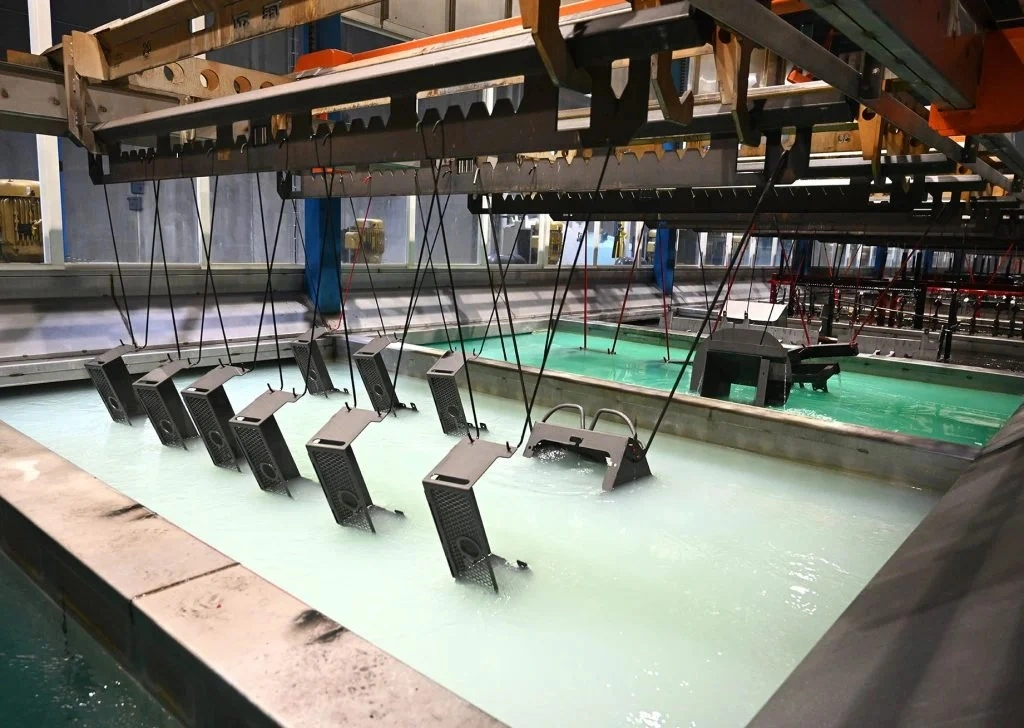
Application and Tank Management: Precision in the E-Coat Bath
The e-coat application tank is the core of the Electric Appliances E-Coating Line, requiring meticulous management.
Tank Design: Large, insulated stainless steel tanks designed for continuous immersion of racks or continuous conveyor systems carrying appliance parts. Efficient agitation and filtration systems are integrated.
Application Parameters: Key variables tightly controlled:
Voltage: Directly influences film build and throwing power. Higher voltage generally increases build but requires careful optimization to avoid film defects.
Bath Temperature: Affects viscosity, deposition rate, and film properties. Typically maintained within a narrow range (e.g., 80-90°F / 27-32°C).
Bath Solids Content: The percentage of non-volatile material (resin, pigment) in the bath. Controlled by additions of paint concentrate and ultra-filtrate (UF).
pH and Conductivity: Critical indicators of bath health and deposition characteristics. Monitored continuously.
Immersion Time: Determines the ultimate film thickness achievable.
Ultrafiltration (UF): An essential component of a modern Electric Appliances E-Coating Line. UF membranes continuously filter the bath, separating out excess water, dissolved salts, and impurities while retaining paint solids and valuable resin. The UF permeate (clear liquid) is used extensively:
Post E-Coat Rinsing: Multiple counter-current rinse stages (RO/DI rinse, UF permeate rinse) recover dragged-out paint from parts, achieving >99% paint utilization efficiency. This is a major environmental and economic benefit.
Bath Control: UF helps maintain bath solids, conductivity, and pH within specification.
Agitation and Filtration: Continuous low-shear agitation prevents pigment settling and ensures bath homogeneity. Bag or cartridge filtration removes particulate contaminants.
Curing: Transforming the Film into a Durable Finish
After deposition and rinsing, the e-coated appliance parts carry a water-saturated film that is not yet fully protective or durable. Curing crosslinks the resin, creating the final robust finish.
The Need for Cure: The applied film is thermoplastic. Heat initiates chemical reactions (crosslinking) between the resin and a curing agent (often blocked isocyanate in cathodic systems), transforming it into a thermoset coating.
Curing Ovens: Electric Appliances E-Coating Lines utilize convection ovens, typically gas-fired or electric. Precise temperature profiling is critical:
Heat-Up Zones: Allow parts to gradually reach peak metal temperature (PMT) without causing solvent pop or other defects.
Peak Metal Temperature (PMT) Zone: Parts must reach the specific temperature required by the e-coat chemistry (commonly 160-190°C / 320-375°F) and maintain it for the specified time (e.g., 15-30 minutes). This ensures complete crosslinking.
Cool-Down Zones: Controlled cooling prevents thermal shock and potential film stress.
Importance of PMT: Undercure leads to soft, easily damaged films with poor chemical resistance and adhesion. Overcure can cause brittleness, discoloration, or loss of adhesion. Monitoring actual part temperature (not just oven air temperature) is essential for consistent quality in the Electric Appliances E-Coating Line.
Quality Control and Testing: Ensuring Appliance Finish Excellence
Rigorous quality control (QC) protocols are integrated throughout the Electric Appliances E-Coating Line to guarantee the finish meets stringent performance standards.
In-Line Monitoring:
Pretreatment: Checks for coating weight (mg/sq ft) and crystal structure (microscopy) of phosphate layers; bath titrations for concentration.
E-Coat Bath: Continuous monitoring of solids content, pH, conductivity, temperature; regular checks of pigment/binder ratio, MEQ (milliequivalents).
Curing: Continuous monitoring of oven temperatures; regular verification using temperature-indicating strips or data loggers on actual parts to confirm PMT is achieved.
Film Properties Testing (On Sample Panels or Parts):
Film Thickness: Measured using magnetic or eddy current gauges. Critical for performance and appearance consistency.
Adhesion: Assessed via cross-hatch and tape tests (ASTM D3359). Excellent adhesion is fundamental.
Corrosion Resistance: Accelerated testing is paramount (e.g., Salt Spray Testing per ASTM B117, Cyclic Corrosion Testing). Appliances must withstand humid, condensing environments and potential exposure to cleaning chemicals.
Chemical Resistance: Testing resistance to common household chemicals (cleaners, acids, bases).
Impact Resistance & Flexibility: Ensuring the finish can withstand handling, installation, and minor impacts without cracking or chipping (e.g., impact tester, mandrel bend test).
Appearance: Color matching (spectrophotometer), gloss measurement, visual inspection for defects like craters, runs, dirt, or poor coverage.
Data Management: Modern Electric Appliances E-Coating Lines often integrate data logging systems to track key parameters over time, enabling traceability, process optimization, and troubleshooting.
Conclusion
Investing in and optimizing an Electric Appliances E-Coating Line is not merely an operational expense; it's a strategic decision with far-reaching benefits. This technology delivers the exceptional corrosion protection demanded by warranties and consumer expectations, ensuring appliances look new for longer. The unmatched uniformity and edge coverage eliminate weak spots in the finish. The high transfer efficiency (>95%), driven by UF rinse recovery, minimizes paint waste and VOC emissions, aligning with stringent environmental regulations and sustainability goals. The automation potential within the line enhances throughput and reduces labor costs while ensuring consistent quality batch after batch.
From the meticulous science of deposition and the non-negotiable importance of pretreatment, through the precise control of the application bath and UF system, to the transformative power of proper curing and the vigilance of rigorous QC, each element of the Electric Appliances E-Coating Line contributes to producing durable, attractive, and high-performing appliance finishes. For manufacturers committed to excellence, efficiency, and environmental stewardship, mastering the e-coating process is an essential component of modern appliance manufacturing. Optimizing this line translates directly into enhanced product quality, reduced warranty claims, lower operational costs, and a stronger competitive position in the global marketplace.



